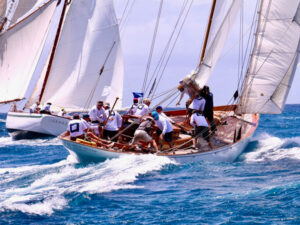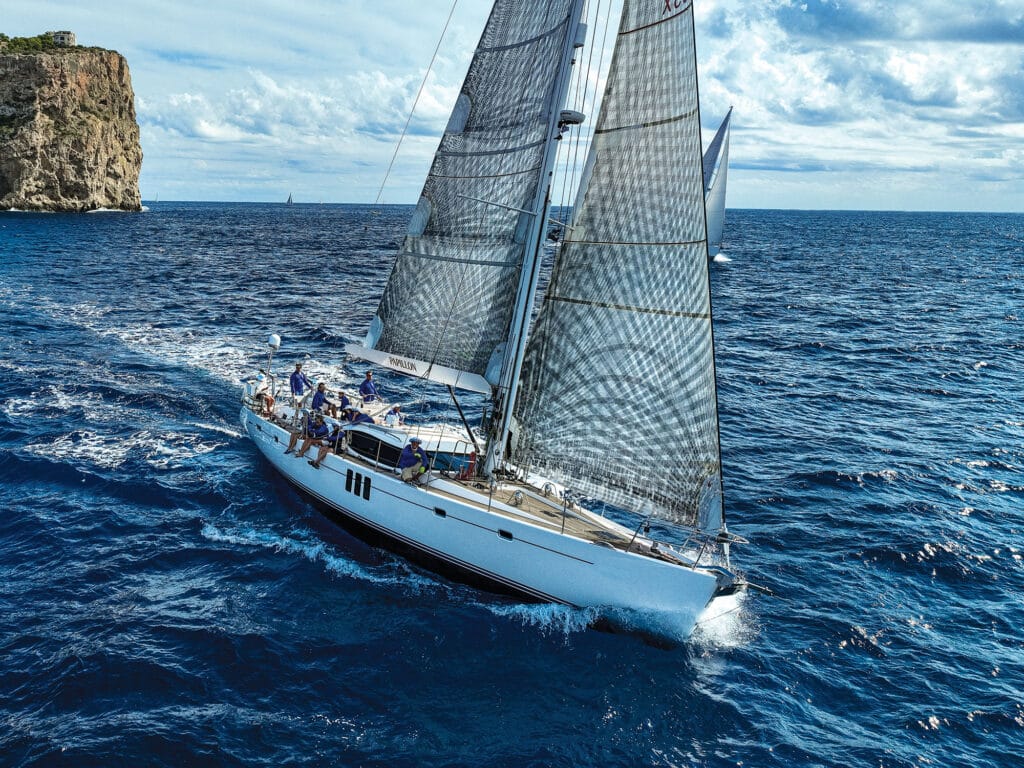
Barry and Sue Parkin had already lost one sail. They were really, really hoping that they wouldn’t lose another as they screamed toward the finish line.
Their No. 3 jib tore straight across and blew apart the second time they took the helm of their recently purchased Oyster 625, Papillon. It was a 2013 build, and the sails that came with it were probably a decade old, with levels of wear and tear that they were still sussing out during September’s Oyster Palma Regatta off Spain’s Balearic Isles.
“Every time we did a sail maneuver, it was the first time we’d done it on that boat,” Barry says. “We were working on how to get these sails up.”
Now, it was the last of three days of racing, and Papillon was in a battle for first place with the Oyster 625 Peregrine Falcon. With their résumés as Olympic sailors, the Parkins certainly had their competition worried, but what had started out as a 5-knot breeze had whipped up to a 20-knot blow. As they pushed the boat on the last leg of the course, they didn’t know if the old genoa would hold.
“These were laminate racing sails,” Barry says, adding that they had deteriorated just by being stored. Still, the Parkins kept the pressure on. “They have some good crew on Oysters. Some of the other boats had professional sailors on board.”
If you had asked the couple a few decades ago whether they would likely find themselves in that kind of a race, aboard that kind of a sailboat, they both likely would have said no. But now that they’re both 58 years old, with three of their four children out of school, they’re starting to think about sailing a lot differently.
Back in the 1980s and ’90s—when you didn’t have to be a full-time sailor to compete in the Olympic Games—Barry and Sue were both good amateurs. He’d grown up in southwest England, in Falmouth, while she was raised in Brightlingsea on Britain’s east coast. They both learned to sail and race as kids and continued racing through college, until they graduated and got jobs. Sue became a math and physical education teacher, while Barry became a graduate trainee as an engineer with Mars Inc., building and designing production lines.
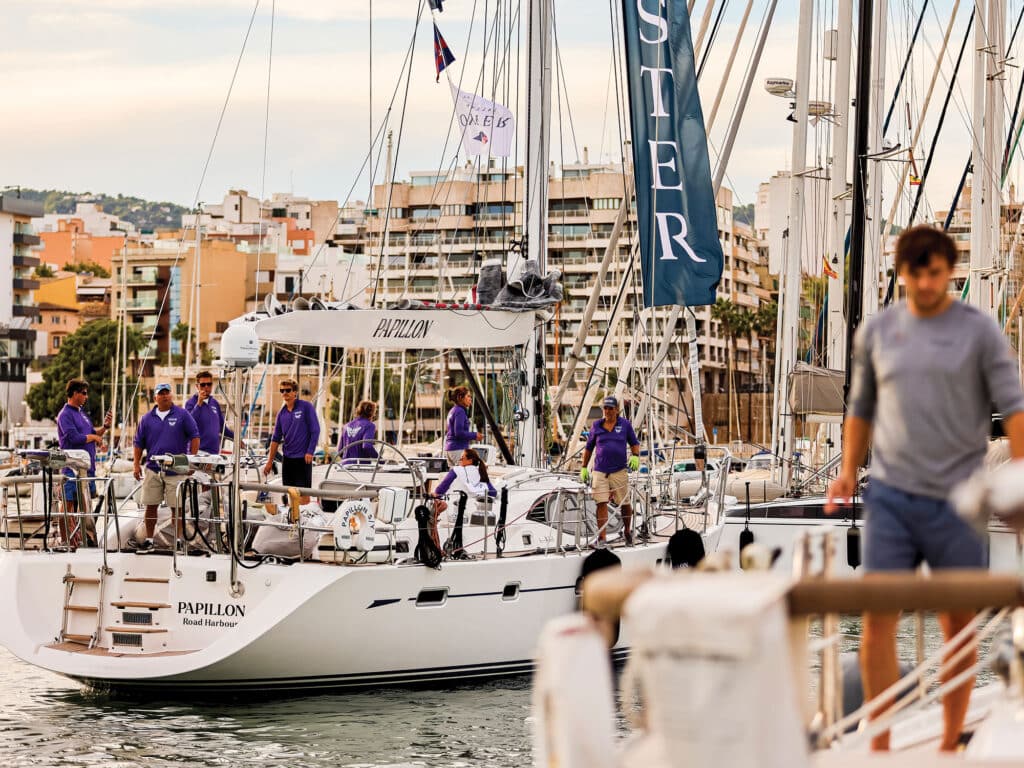
“We both then carried on racing at the highest level we could, using all of our vacations and weekends,” Barry says. “Sue went to the Olympics very young. She went to the 1988 Olympics in the 470, then again in ’92 and ’96. She did that while continuing to do women’s match racing in keel boats between each of the Olympics while still working full and part time.”
It took him a bit longer to get to the Games, but while working his way through different jobs with Mars and racing all over the world, he kept at it. “I really had a serious attempt at the Olympics at the end of ’94, when I was 30,” he says. “I got together with a team, and we went to the Olympics in ’96 and 2000.”
It was during the run up to the 1996 Olympic Games in Atlanta that Barry and Sue became really good friends as teammates. They married soon after.
Meanwhile, Barry’s career at Mars kept advancing, all the way to global head of procurement and sustainability, the job he holds today. “I’ve worked for them for 37 years now,” he says. “During the period when I was training for the Olympics, I was at director level, and they supported me by giving me a lot of time off to train. But the week after the Olympics finished, I went back to work and carried on with my career.”
Still, both he and Sue have continued to race—now for Uncle Sam, as US nationals who split their time between Connecticut and Florida. Ahead of the Oyster regatta in September, Barry competed in the International Etchells Worlds in Cowes, England, and he’s planning to compete in the Etchells World Championship in April on Miami’s Biscayne Bay. Some of their kids too have caught the bug; 24-year-old Jack was a world youth champion who’s now an investment banker at JPMorgan in New York, sailing in his spare time, while 16-year-old Freddie—still in high school—became world youth champion on the 420 in July 2022 on the North Sea.
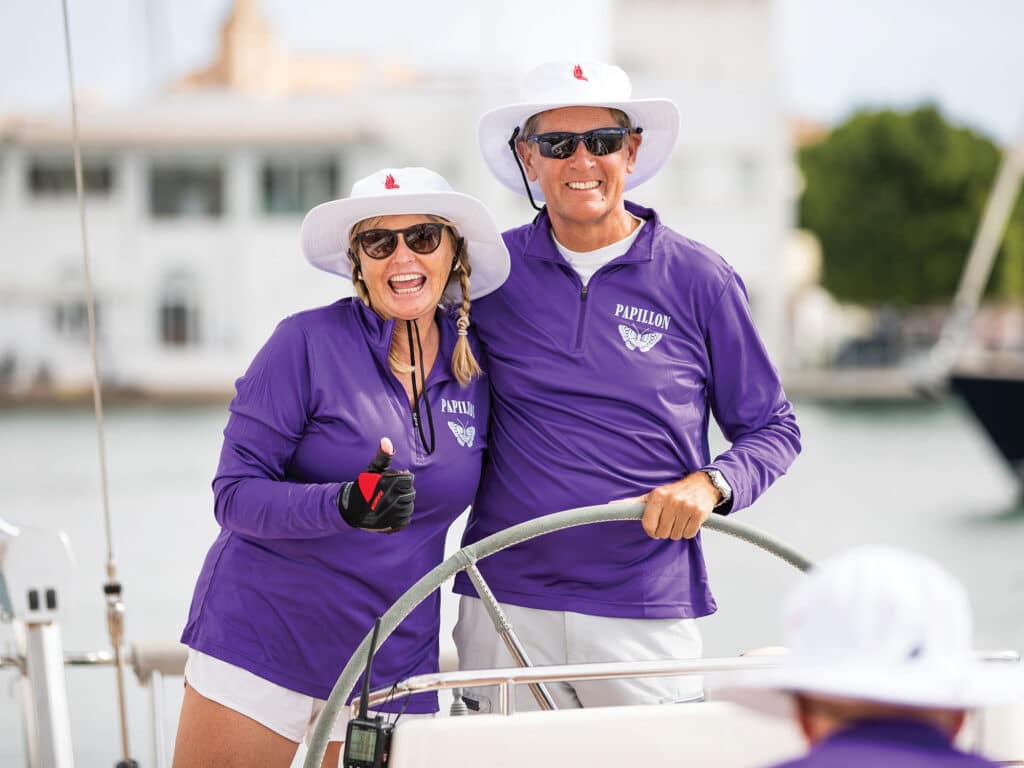
Sometimes, just for fun, they all head out on Long Island Sound to race against one another.
“Riverside Yacht Club in Connecticut, where we live in the summer, has the biggest frostbiting fleet in the country,” Barry says. “These are singlehanded, and on any given Sunday in the winter, you’ll have about 50 boats on the start line. It’s all weight-equalized, so we can all race each other. We’re very competitive. [My sons] generally beat me now—not always, but generally. I say, ‘Sure, you can beat me in a 10-foot boat, but maybe not in a 30-foot boat.’”
The couple did have boats of their own before buying the Oyster 625, with their biggest previously being a 36-foot Sessa powerboat for cruising in the Northeast (because, Barry says, “there’s not a lot of wind in the summer up there”). But with Freddie now looking at colleges and the other three kids well into adulthood, they have a vision of setting a course much farther into the distance.
“Susie’s always had this dream that once the kids are gone, we’ll head off and do some cruising, see parts of the world we’ve never seen,” Barry says. “We have this idea of sailing around the world.”
Hence, the shopping began for a boat that would let them do it. Oysters are built near where Sue grew up in Britain, and the couple knows people who work for the yard. They always liked Oyster yachts—a premium brand made for shorthanded, comfortable, bluewater cruising—but what really sold them was the Oyster owners’ association and the company’s Oyster World Rally, a fully supported, global circumnavigation that starts and ends at the Caribbean island of Antigua.
“You’re cruising in company with the technical support and the peer support,” Barry says. “They train you, and you have great social events. So it lowers the bar on doing that trip considerably, versus heading off on your own. It makes it accessible to people who don’t have a lot of experience, which is us.”
The biggest challenge, he says, will be learning to make sense of such a complex boat. He’s learning all the Oyster 625’s systems—generators, watermakers, ice makers, air conditioning, navigation equipment—that never factored into the Parkins’ racing lives.
“Then there’s the challenge of being on a boat day after day after day,” he says. “All of that is completely different from the challenges of racing on a small boat, where you’re on the water for maybe six or eight hours, maybe an overnight race, but it’s a sprint. You’re concerned about what might break on the boat, but you have very different safety considerations.”
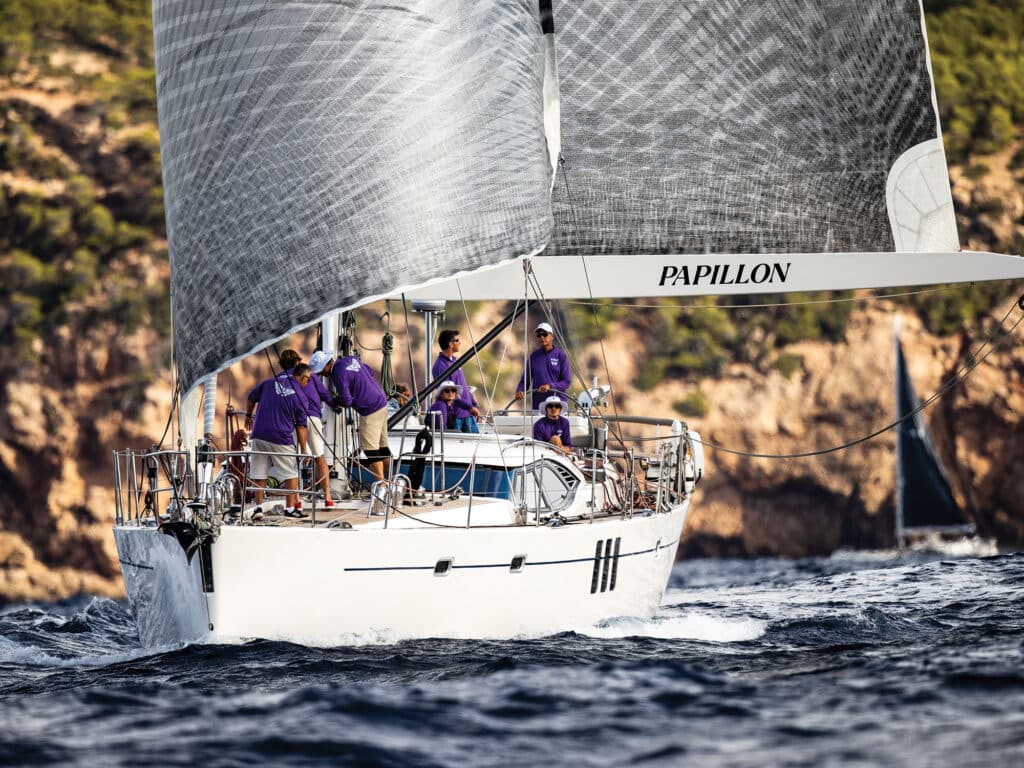
So far, they’re happy with their choice of Papillon. Buying Hull No. 5 (previously Lady Mariposa) substantially reduced their required upfront investment, and they’ve put the boat into the Oyster Yachts charter fleet at a weekly base rate of $22,000 to help offset their expenses. This winter, Papillon will be in the Caribbean, where they plan to cruise in between charter use. For summer 2023, the boat will be in New England, and they hope to do the Newport Bermuda Race in 2024.
Somewhere along the way, they’re eagerly anticipating spending their first-ever night aboard while sailing offshore.
“I’ve spent many days and nights on boats in the past, but an Oyster is pretty luxurious,” Barry says. “You’re not slumming it. The owner’s cabin in the back is full width. It’s really, really nice.”
And, of course, they’ll be racing Papillon when the opportunity arises, as it did in the Balearic Isles shortly after they took delivery in fall 2022—when they were in a battle for first place aboard their boat that they barely knew, and weren’t sure if the genoa would hold.
Despite their best efforts that day, the old sail gave out on them after about five hours of racing, just before Papillon got to the finish. Peregrine Falcon took the top spot.
“We had to put up a different one. It was just another older sail, but that cost us the win,” Barry says. “But we were there to have fun, so we weren’t that upset. We learned a lot about the boat, which sails great. It will do 9½ knots upwind and 12 knots off the wind with an asymmetric up.”
Barry, Sue and all their friends who were on board that day are eager for another shot at a win. Their next opportunity against the Oyster fleet will be the Oyster Antigua Regatta in April, based at Nelson’s Dockyard in English Harbour.
There’s likely to be a sizable roster of skilled competitors there too, given that the regatta will include a celebration of Oyster’s 50th year in business, as well as a welcome home for boats completing the 2022-23 Oyster World Rally.
Fair notice to all: By then, the Parkins will have Papillon’s new sails.



